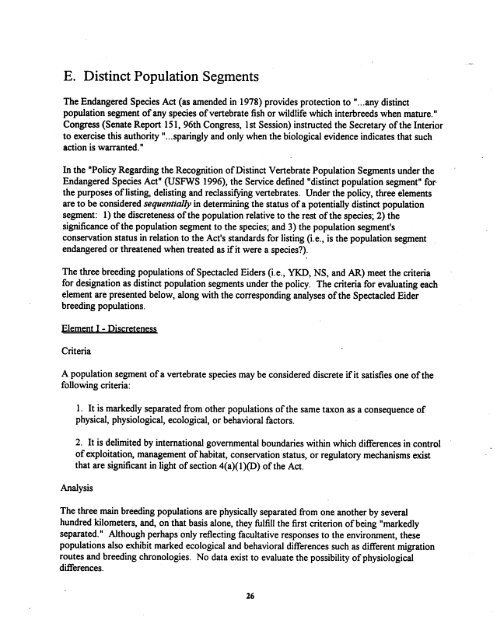A. Status of the Spectacled Eider - U.S. Fish and Wildlife Service
A. Status of the Spectacled Eider - U.S. Fish and Wildlife Service
A. Status of the Spectacled Eider - U.S. Fish and Wildlife Service
You also want an ePaper? Increase the reach of your titles
YUMPU automatically turns print PDFs into web optimized ePapers that Google loves.
E. Distinct Population Segments<br />
The Endangered Species Act (as amended in 1978) provides protection to “...any distinct<br />
population segment <strong>of</strong>any species <strong>of</strong>vertebrate fish or wildlife which interbreeds when mature.”<br />
Congress (Senate Report 151, 96th Congress, 1st Session) instructed <strong>the</strong> Secretary <strong>of</strong><strong>the</strong> Interior<br />
to exercise this authority “...sparingly <strong>and</strong> only when <strong>the</strong> biological evidence indicates that such<br />
action is warranted.”<br />
In <strong>the</strong> “Policy Regarding <strong>the</strong> Recognition <strong>of</strong>Distinct Vertebrate Population Segments under <strong>the</strong><br />
Endangered Species Act” (USFWS 1996), <strong>the</strong> <strong>Service</strong> defined “distinct population segment” for<strong>the</strong><br />
purposes <strong>of</strong>listing, delisting <strong>and</strong> reclassif~,’ing vertebrates. Under <strong>the</strong> policy, three elements<br />
are to be considered sequentially in determining <strong>the</strong> status <strong>of</strong>a potentially distinct population<br />
segment: 1) <strong>the</strong> discreteness <strong>of</strong><strong>the</strong> population relative to <strong>the</strong> rest <strong>of</strong><strong>the</strong> species; 2) <strong>the</strong><br />
significance <strong>of</strong><strong>the</strong> population segment to <strong>the</strong> species; <strong>and</strong> 3) <strong>the</strong> population segment’s<br />
conservation status in relation to <strong>the</strong> Act’s st<strong>and</strong>ards for listing (i.e., is <strong>the</strong> population segment<br />
endangered or threatened when treated as ifit were a species?).<br />
The three breeding populations <strong>of</strong><strong>Spectacled</strong> <strong>Eider</strong>s (i.e., YKD, NS, <strong>and</strong> AR) meet <strong>the</strong> criteria<br />
for designation as distinct population segments under <strong>the</strong> policy. The criteria for evaluating each<br />
element are presented below, along with <strong>the</strong> corresponding analyses <strong>of</strong><strong>the</strong> <strong>Spectacled</strong> <strong>Eider</strong><br />
breeding populations.<br />
Element I - Discreteness<br />
Criteria<br />
A population segment <strong>of</strong>a vertebrate species may be considered discrete ifit satisfies one <strong>of</strong><strong>the</strong><br />
following criteria:<br />
1. It is markedly separated from o<strong>the</strong>r populations <strong>of</strong><strong>the</strong> same taxon as a consequence <strong>of</strong><br />
physical, physiological, ecological, or behavioral factors.<br />
2. It is delimited by international governmental boundaries within which differences in control<br />
<strong>of</strong>exploitation, management <strong>of</strong>habitat, conservation status, or regulatory mechanisms exist<br />
that are significant in light <strong>of</strong>section 4(a)( 1 )(D) <strong>of</strong><strong>the</strong> Act.<br />
Analysis<br />
The three main breeding populations are physically separated from one ano<strong>the</strong>r by several<br />
hundred kilometers, <strong>and</strong>, on that basis alone, <strong>the</strong>y fulfill <strong>the</strong> first criterion <strong>of</strong>being “markedly<br />
separated.” Although perhaps only reflecting facultative responses to <strong>the</strong> environment, <strong>the</strong>se<br />
populations also exhibit marked ecological <strong>and</strong> behavioral differences such as different migration<br />
routes <strong>and</strong> breeding chronologies. No data exist to evaluate <strong>the</strong> possibility <strong>of</strong>physiological<br />
differences.<br />
26

















